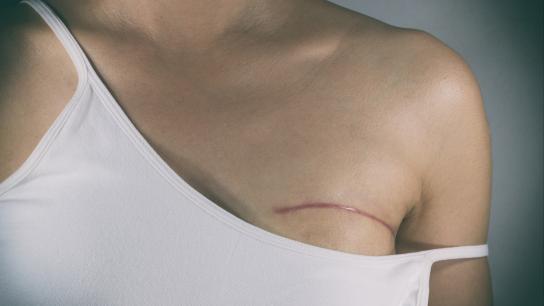
Once upon a time, scarring was a tell-tale sign that you’d “had work done.” Nowadays? Not so much. While a scar is a natural and inevitable byproduct of any surgical incision, today’s plastic surgeons are highly skilled at planning a surgical incision in order to minimize and/or hide visible scarring.
We sat down with board-certified plastic surgeon and ASAP member Dr. Michael Kulick, to discuss just how detailed surgical scar and incision planning has become.
“Regardless of the specific procedure, my top priority is to have the best well-hidden scar, because once you have an incision, there will be a scar, that will always be there,” Dr. Kulick says of his own philosophy toward scar planning. So let’s take a look at the various consideration that your surgeon will need to take into account when planning your incision and resulting scar.
Location.
“Just like in real estate the key to a good scar is location, location, location,” Dr. Kulick explains. “With a facelift you want to place an incision where most people won’t see it, and you plan the surgical procedure accordingly.” Dr. Kulick makes a zig-zag pattern incision that produces a less visible scar, than a typical straight line incision would. Stopping just behind the ear and avoiding extending into the hairline allows for hair to grow through the incision area, providing even more camouflage—an added bonus for patients with short hair or for patients that like to pull their hair into a ponytail.
Procedure.
For other procedures, like a tummy tuck, location runs the risk of being upstaged by the specifics of the procedure itself.
“A tummy tuck incision will ideally be at or below the bikini line so that it is covered by the underwear, and we make the incision within the confines of that piece of apparel,” Dr. Kulick explains. “But, if you have to remove eight inches of skin, there is no way to remove it and have a scar that parallels one left behind when removing only one inch of skin. Someone that has less excess weight will have a smaller scar. Regardless, you want the best possible scar for each individual patient.”
Noted. Incision and scar planning is procedure specific.
Patient details.
And lest you think procedure details are the end all be all—they’re not. Your surgeon will consider each patients desired outcome, as well as all the variables that make you… well, you. Skin tone and laxity, age, weight, lifestyle, will all be considered by your surgeon when they’re planning your incision. Age, for example, can play a part in determining where a scar will best be hidden—particularly when it comes to breast augmentations
“If someone is in their twenties and has breasts that don’t require skin removal, I’ll give them the option of having the incision around the areola, under the breast or underneath the armpit,” explains Dr. Kulick. “In my practice, most will choose under the armpit because that scar isn’t visible to anyone. If you don’t have to do a breast lift at the same time, the incision under the armpit is the most favorable location.” (Ahem… unless you give a lot of high-fives. Just sayin’.) “If you are doing a breast lift or need to elevate the location of areola and you have to remove extra skin, the scar will need to be under the breast and/or around the areola.”
You: Got it. Location + procedure + patient details. Right? That’s it?
Us: Nope.
Tension.
There are also variables like tension that need to be considered—and, by ‘tension’, we’re not talking about a mental showdown between you and the breakfast that you won’t be allowed to eat the morning of your surgery.
Tension is any stress that is put on your incision. Whether it’s your surgeon minimizing tension on the skin’s edges as he or she closes the incision, or you bending, lifting, stretching—all the things your surgeon tells you not to do for a specific amount of time post-surgery, tension, in a word, is ‘bad.’ “Having tension on the scar is not a good thing because those scars tend to be larger,” Dr. Kulick explains. ‘Larger’—not exactly the detail you want describing your post-surgical scar.
Genetics.
“Last but not least, the wildcard factor is genetics,” Dr. Kulick pulls out a gambling reference, scoring mad points. “Not everyone heals the same way.”
No they don’t. The skin on the breast and chest responds differently to healing than the skin behind the ear—even if all that skin resides on the same body. And just as we all heal differently, some patients can be prone to scarring disorders, like keloids and hypertrophic scarring.
Keloid scars occur when your healing process goes into overachiever mode and creates more collagen than necessary, causing raised, ridged scars that grow outside of the boundaries of the actual incision. Hypertrophic scarring is similar, a raised, red scar that stays inside the boundaries of the incision. Think keloid-lite. Neither are all that attractive and if having a less-obvious scar is on your to-do list, you’ll want to inform your surgeon if anyone in your family has experienced keloids or hypertrophic scarring in the past.
Race also factors into incision and scar planning, as certain scarring disorders—like keloids—tend to have a genetic component to them. These disorders affect those of African, Latino and Asian descent more than they do those of European decent. Which just adds insult to injury when you consider that certain scars, even if neatly healed, can seem more apparent on darker skin tones as they sometimes heal in lighter shades than the surrounding skin. *Sigh. All is not lost, however. A frank discussion with you surgeon about what to expect and what can be done should a less-than-minimal scar creep its way into your life will help exponentially.
You.
And finally, the last thing your surgeon (and you) will want to consider is your own ability and willingness to follow directions. Infection, sun exposure and the aforementioned ‘tension’ can all undo the careful planning of even the most scar-sensitive surgeons, so ensuring that you follow your doctor’s post-surgical directions is tantamount to the best possible result. Be sure to care for your incision by following your post-op instructions to a T, and should you see the slightest sign of infection, immediately inform your surgeon. Don’t expose your incision and impending scar to the ravages of direct sunlight (sunscreen, sunscreen, sunscreen)—new, healing skin will be more sensitive to sun damage. And if your surgeon recommends that your use pressure dressings, sports bras, topical silicon agents—use them.
Better fitting clothing, a perked up appearance, even increased confidence—many good things can come out of a successful cosmetic procedure. A big scar ain’t one of ‘em. Ensuring that your plastic surgeon is experienced in incision and surgical scar planning is a big step in the right direction toward minimally visible evidence of your procedure.








